Table of Contents
Introduction
Linear motors are a type of electric motor that generates motion in a straight line, as opposed to the rotational motion of a conventional motor. The core of a linear motor plays a crucial role in its operation, influencing both efficiency and performance. This article explores the various applications of linear motor cores across different industries, shedding light on their importance and potential future developments.
Understanding Linear Motors
What is a Linear Motor?
A linear motor is an electric motor that has been unrolled to produce linear motion. Unlike traditional motors that generate torque, linear motors generate force in a straight line. They are commonly used in applications where precise and direct linear movement is required.
Key Components of Linear Motors
The primary components of a linear motor include the stator, the mover (or rotor in the case of rotary motors), and the core. The stator is a stationary part that creates the magnetic field, while the mover travels along the stator to create motion. The core, usually made of ferromagnetic material, is essential for concentrating the magnetic flux and enhancing the motor’s efficiency.
Role of the Core in Linear Motors
Definition and Function of a Linear Motor Core
The core in a linear motor is the part that provides a path for the magnetic flux generated by the stator. It is typically made from laminated sheets of iron or other magnetic materials to minimize eddy current losses. The core’s primary function is to focus the magnetic field, thereby increasing the efficiency of the motor.
Types of Cores Used in Linear Motors
Linear motors can use different types of cores depending on the application. The most common types include iron-core and ironless-core motors. Iron-core motors are known for their high force density, making them suitable for heavy-duty applications. Ironless-core motors, on the other hand, are preferred in applications requiring high precision and low cogging force.
Materials Used in Linear Motor Cores
Common Materials for Core Manufacturing
The performance of a linear motor heavily depends on the materials used for its core. The most common materials include silicon steel, ferrite, and other specialized magnetic alloys. Silicon steel is widely used due to its excellent magnetic properties and cost-effectiveness. Ferrite cores are also popular, particularly in applications requiring lightweight and low-cost solutions. Additionally, advancements in material science have led to the development of specialized alloys that offer superior magnetic performance while reducing losses.
Properties That Influence Core Material Selection
Several properties influence the selection of materials for linear motor cores, including magnetic permeability, saturation flux density, and electrical conductivity. High magnetic permeability is desired to maximize the motor’s efficiency by enhancing the magnetic flux. Saturation flux density determines the maximum magnetic field strength that the core material can handle before it saturates, while low electrical conductivity helps minimize eddy current losses. Additionally, factors such as thermal conductivity and mechanical strength are considered, especially in high-performance applications.
Applications of Linear Motor Cores
Industrial Automation
Linear motors are extensively used in industrial automation to achieve high precision and speed in manufacturing processes. The core’s role in these motors is critical for maintaining accuracy and efficiency, especially in applications like CNC machines, packaging equipment, and automated assembly lines. The use of linear motor cores in these settings allows for smooth and precise control, leading to improved product quality and increased production rates.
Transportation Systems
One of the most well-known applications of linear motor cores is in transportation systems, particularly in maglev (magnetic levitation) trains. These trains rely on linear motors to achieve high speeds with minimal friction. The cores in these motors are designed to handle significant forces and sustain continuous operation over long distances. This application showcases the core’s ability to support both high power and efficiency in demanding environments.
Robotics
In robotics, linear motors are used for precision movement and positioning. The core in these motors is vital for ensuring accurate and repeatable motion, which is essential in tasks such as robotic arms used in assembly lines or automated systems. The precise control offered by linear motor cores allows robots to perform complex operations with high accuracy, making them indispensable in modern manufacturing and automation processes.
Conclusion
Linear motor cores are integral to the functionality and efficiency of linear motors across various industries. Their applications range from industrial automation and transportation systems to robotics and medical devices. As technology advances, the materials and designs of these cores will continue to evolve, offering even greater performance and efficiency in future applications.


